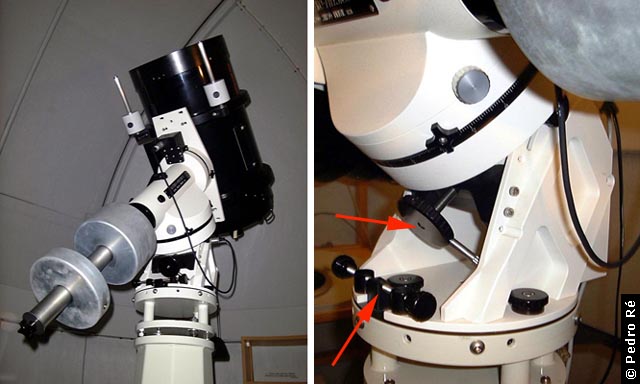
Astrophysics 1200 GTO mount (IGeoE)
1. Set up your scope as normal. Use one of the many methods to roughly align using Polaris. This can be as rough as just getting Polaris in the center of your sighter scope. The closer you get here, the shorter time you will spend drifting. (Hint: Level your tripod or fixed pier - it makes life easier)

2. Put a diagonal and illuminated guiding eyepiece in your scope. About 200 power is the minimum needed for adequate sensitivity during drifting. Rotate the eyepiece so that a star moves parallel to the crosshairs in Dec and RA when using the slow motion controls. Align it so that Dec is up and down (North & South) and RA is right and left (East & West).

3. Find a star very near the meridian and about +20 degrees declination and align it to the center of the guiding eyepiece. Let your scope track (you may guide in RA only if you wish) and watch for Dec drift (up or down). Unless your alignment is very close, you will see drift in 5 to 30 seconds (you can work with out of focus images).
4. If the star drifts up, turn the azimuth knob that makes the star move right in the field. If the star drifts down, turn the azimuth knob that makes the star move left in the field (These adjustments are reversed for a Newtonian). After adjustment, use the slow motion controls to re-center the star. Repeat this until there is no drift for at least 5 minutes. Note: If you see drift in less than 5 seconds at 200X, you are probably 10 or more eyepiece fields off in azimuth. Give the knob a good crank. This may have to be repeated 3 or 4 times to notice the drift slowing. If you don't see any drift for 30 seconds or so, you may only be 1 or 2 eyepiece fields off. Make your azimuth adjustment accordingly. If after adjustment the star drifts in the opposite direction, you went too far.

5. Find a star on the equator and within 15 degrees of either the Eastern or Western horizon. Repeat (2) and use the guidelines from (3) and (4). For Eastern horizon: if the star drifts up, adjust the elevation to move the star down. If the star drifts down, adjust the elevation to move the star up. For Western horizon: if the star drifts up, adjust the elevation to move the star up. If the star drifts down, adjust the elevation to move the star down. Repeat until there is no drift for at least 5 minutes.
6. If you made a large correction in elevation (several degrees or more), go back and check the azimuth, otherwise you are done. With a little practice, it ought to be possible to complete the procedure before the end of twilight. Try it in your back yard until you are confident. I have found this method to be accurate enough for astrophotographs of up to 3 hours for small fields (less than 1 degree) and up to 2 hours for larger fields (up to 5 degrees) for declinations between +70 and -70 degrees. For exposures longer than these and closer to the poles, a photographic method of polar alignment that is applicable only to permanent installations may be required.
7. It must be emphasized that the star cannot drift at all for 5 minutes to achieve the exposure times stated above. If you judge the drift by bisecting a star with a line in an illuminated eyepiece the star must stay bisected for the full 5 minutes. Experience has shown that if the star has drifted as little as half it's diameter then field rotation will begin to creep into long exposures.